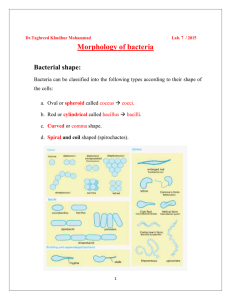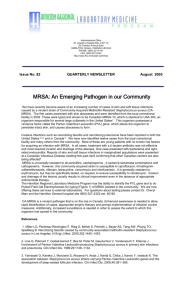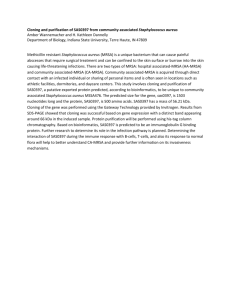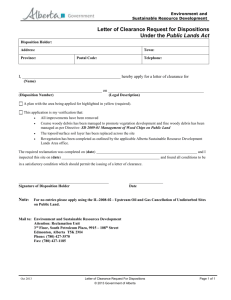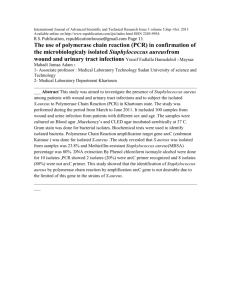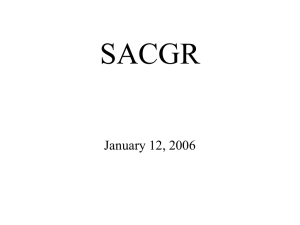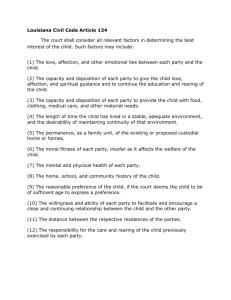IDO-Staph - Buffalo Ontology Site
advertisement
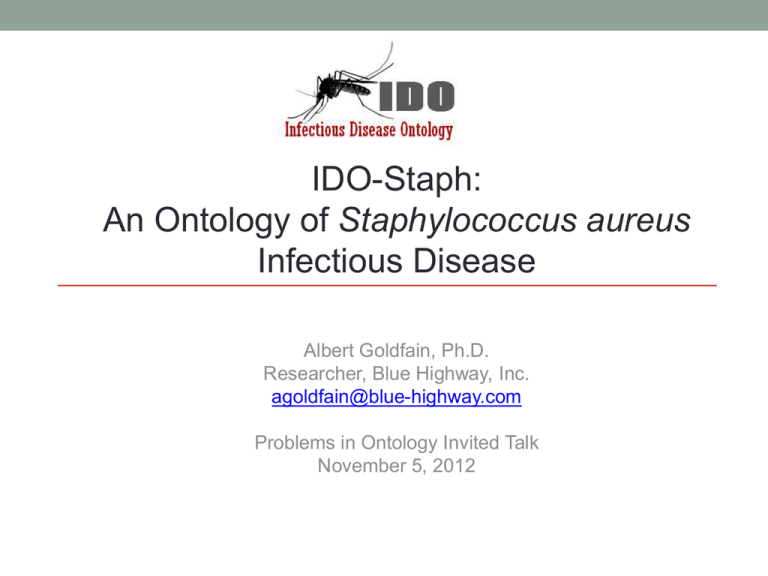
IDO-Staph:
An Ontology of Staphylococcus aureus
Infectious Disease
Albert Goldfain, Ph.D.
Researcher, Blue Highway, Inc.
agoldfain@blue-highway.com
Problems in Ontology Invited Talk
November 5, 2012
Outline
I.
II.
III.
IV.
V.
VI.
Motivation: Disease ontologies for precision medicine
The IDO-Staph extension
Differentiating Staph aureus infectious diseases
A lattice of Staph aureus infectious diseases
A blocking-disposition account of antibiotic resistance
(Time permitting) Complimentary and collective
dispositions in IDO.
Motivation: “Toward Precision Medicine: Building a Knowledge
Network for Biomedical Research and a New Taxonomy of
Disease”
International Classification of Diseases
• Versions:
• ICD-9 (1977)
• ICD-10 (1992)
• ICD-11 (2015)
• Lag time in releases lag time in incorporating new
knowledge about disease
• Not suited for continuous integration of molecular, genetic
information…
• …which is now being generated at an increasing pace
• Coding-systems used for billing should not be repurposed
for meaningful information interchange and clinical
decision support
ICD 9: Catch-all Codes and
Scattered Exclusions
• 041 Bacterial infection in conditions classified elsewhere and of unspecified
site
• Note: This category is provided to be used as an additional code to identify the
bacterial agent in diseases classified elsewhere. This category will also be used to
classify bacterial infections of unspecified nature or site.
• Excludes: septicemia (038.0-038.9)
• 041.1 Staphylococcus
• 041.10 Staphylococcus, unspecified
• 041.11 Methicillin susceptible Staphylococcus aureus
• MSSA
• Staphylococcus aureus NOS
• 041.12 Methicillin resistant Staphylococcus aureus
• Methicillin-resistant staphylococcus aureus (MRSA)
• 041.19 Other Staphylococcus
• 038 Septicemia
• 038.1 Staphylococcal septicemia
• 038.10 Staphylococcal septicemia, unspecified
• 038.11 Methicillin susceptible Staphylococcus aureus septicemia
• MSSA septicemia
• Staphylococcus aureus septicemia NOS
• 038.12 Methicillin resistant Staphylococcus aureus septicemia
• 038.19 Other staphylococcal septicemia
ICD 9: Catch-all Codes and
Scattered Exclusions
• 041 Bacterial infection in conditions classified elsewhere and of unspecified
site
• Note: This category is provided to be used as an additional code to identify the
bacterial agent in diseases classified elsewhere. This category will also be used to
classify bacterial infections of unspecified nature or site.
[041.19] Other Staphylococcus
• Excludes: septicemia (038.0-038.9)
• 041.1[041]
Staphylococcus
Bacterial infection in conditions classified elsewhere and of
• 041.10 Staphylococcus, unspecified
unspecified site.
• 041.11 Methicillin susceptible Staphylococcus aureus
• MSSA
• Staphylococcus aureus NOS
• 041.12 Methicillin resistant Staphylococcus aureus
• Methicillin-resistant staphylococcus aureus (MRSA)
• 041.19 Other Staphylococcus
• 038 Septicemia
• 038.1 Staphylococcal septicemia
• 038.10 Staphylococcal septicemia, unspecified
• 038.11 Methicillin susceptible Staphylococcus aureus septicemia
• MSSA septicemia
• Staphylococcus aureus septicemia NOS
• 038.12 Methicillin resistant Staphylococcus aureus septicemia
• 038.19 Other staphylococcal septicemia
Motivation: The Antibiotic Race
Year
Antibiotic Effectiveness
1943
Penicillin available
1947
First resistant strains reported
1960s Switch to methicillin
1961
Methicillin-resistant strain found in Cairo
1980s Methicillin resistance rising, vancomycin used as a last resort
1992
15% methicillin-resistant
1996
35% methicillin-resistant
2000
50% methicillin-resistant
2002
Vancomycin resistance reported
(from Knobler et al, 2003)
Motivation: IDO Extension ontologies in
the BFO/OGMS/IDO framework
• What makes ontologies like IDO and IDO-Staph
•
•
•
•
•
interesting from the perspective of ontology development?
Host-Pathogen Interactions: The parts and processes of
two organisms must be modeled.
Co-evolution of biological functions
Transmission processes and the chain of infection
Horizontal gene transfer and clonal nature of Staph
aureus
Pace of scientific discoveries about pathogenic strains will
stress test the universals.
IDO-Staph: Introduction
• Initial Release Candidate:
http://purl.obolibrary.org/obo/ido/sa.owl
• Google Code Page: http://code.google.com/p/ido-staph/
• Scope
• Entities specific to Staphylococcus aureus (Sa) infectious diseases at
multiple granularities
• Biological and clinical terms describing host-Sa interactions
• An IDO extension ontology
• Extends IDO-Core, OGMS
• BFO as an upper ontology
• Built on OBO Foundry principles
• Applications
• Annotation of clinical case report forms
• Lattice of infectious diseases
IDO: Core and Extensions Framework
A Lattice of Lightweight
Application-Specific Ontologies
The organism Staphylococcus aureus (Sa)
NCBITaxon:Staphylococcus aureus. IDO-Staph makes several assertions
about this bacteria:
• bearer_of SOME pato:‘spherical’ (quality)
• has_disposition SOME (realized_by SOME go:‘aerobic respiration’)
• has_disposition SOME (realized_by SOME go:’fermentation’)
• has_part SOME go:‘gram-positive-bacterium-type cell wall’
• has_part SOME (has_disposition SOME go:‘catalase activity’)
Sa Genes
• IDO-Staph imports ‘gene’ from the Sequence Ontology
• Sa-specific genes from NCIB Gene:
http://ido-staph.googlecode.com/svn/applications/NCBIGene/NCBISaGenes.owl
• Gene results for Staph Aureus: 88625 entries
• Removing genes with hypothetical, putative, pseudo, or unknown
products: 54086 entries
• SELECT DISTINCT gene names: 36096 entries
• Essential genes of Sa as determined by Transposon-
Mediated Differential Hybridization (Chaudhuri et al, 2009)
• 248 genes labeled as essential in all studies covered
• Imported into IDO-Staph along with a GO annotation for their
products.
Sa Genes
• Some Sa genes are only part of Sa at some times
• Example: lukF gene of the bacteriophage
‘Staphylococcal Phage PVL’ inserts itself into the
Sa chromosome
• lukF:
• part_of SOME ‘Staphylococcal Phage PVL’ at all times
• part_of SOME (‘chromosome’ AND
(part_of SOME ‘Staphylococcus aureus’)) at some time
Sa Proteins: Parts and Products
• Toxins, Invasins, Adhesins
from Shetty, Tang, and Andrews, 2009
Sa Proteins
• Asserted hierachy
• PRO:Protein
• Inferred Hierarchy
• Adhesion factor
• Invasion factor
• Toxin
• Exotoxin
• Enterotoxin
• Virulence factor
Regulatory networks
• Proteins are both gene products and regulators of further
protein production
• Sa has two major gene regulation systems
• Staphylococcal accessory regulator (SarA)
• Accessory gene regulator (agr)
• OWL-DL pattern:
• [protein]: {positively|negatively}_regulates
SOME (ido:production AND (has_participant SOME [protein]))
Sa Diseases
• “Staphylococcus aureus is a normal inhabitant of the skin
and mucous membranes in the nose of a healthy human.
Approximately 30% of the normal healthy population is
affected by S. aureus as it asymptomatically colonizes
human hosts” (http://microbewiki.kenyon.edu/index.php/Staphylococcus)
• Whether or not a particular Sa organism is part of an
infectious disorder depends, in part, on its anatomical
location in its host.
Source: http://textbookofbacteriology.net/themicrobialworld/staph.html
Toxic Shock Syndrome
• Staphylococcal TSS is a ido:‘infectious disease’
• has_material_basis SOME
(Sa infectious disorder AND (has_part SOME TSST)
• TSST is a pr:protein
• has_disposition SOME ‘exotoxin disposition’ [INF: is a exotoxin]
• tstH is a so:gene
• has_gene_product SOME TSST
• part_of SOME (SaPI2 OR SaPI3)
• SaPI2 is a so:‘pathogenic island’
• SaPI3 is a so:‘pathogenic island’
Sa Diseases: Asserted Hierarchy
• Primary classification of staphylococcal diseases
• These are first and foremost infectious diseases
• Use DOIDs for disease terms
• Assert ido:‘infectious disease’ as a parent term for these
diseases
Sa Diseases: Inferred Hierarchy
• Secondary classification as Sa Infectious Diseases
Ways of differentiating infectious diseases
• High-level types
• By host type (species)
• By anatomical site of infection
• By signs and symptoms
• By mode of transmission
• By (sub-)species of pathogen
• Differentiation based on host features
• Clinical phenotype
• Strain (e.g. A/J)
• Gene types (e.g. C5-deficient)
• SNP alleles
• Differentiation based on pathogen features
• By phenotype (e.g. drug resistance)
• By genotype
•
•
•
•
By banding patterns (e.g. PFGE)
By typing of house-keeping genes (e.g. MLST)
By virulence factor typing (e.g. spa, SCCmec)
By whole genome?
“Methicillin-Susceptible Staphylococcus aureus Endocarditis Isolates Are Associated with
Clonal Complex 30 Genotype and a Distinct Repertoire of Enterotoxins and Adhesins”
Nienaber et al. 2011 J Infect Dis. 204(5):704-13.
Ways of differentiating Staph aureus
infectious diseases
• Sa Infectious Disease
• By SCCmec type
• By ccr type
• By mec class
• By spa type
• IWG-SCC
• Maintains up-to-date
SCCMec types
• General guidelines for
reporting novel SCCmec
elements
http://www.sccmec.org/Pages/SCC_ClassificationEN.html
SCCMec
(Staphylococcal Chromosome Cassette)
• A mobile genetic element in Staphylococcus aureus that
carries the central determinant for broad-spectrum
beta-lactam resistance encoded by the mecA gene and
has the following features:
• (1) carriage of mecA in a mec gene complex,
• (2) carriage of ccr gene(s) (ccrAB or ccrC) in a ccr gene complex,
• (3) integration at a specific site in the staphylococcal chromosome,
referred to as the integration site sequence for SCC (ISS), which
serves as a target for ccr-mediated recombination, and
• (4) the presence of flanking direct repeat sequences containing the
ISS.
Representing SCCMec: IDO-Staph + SO
is a
gene group
pathogenic island
is a
is a
mec complex
has_part
is a
SCCmec
has_part
ccr complex
is a
is a
mec complex class B
SCCmec Type IV
ccr complex Type 2
has_part
has_part
has_part
IS1272
is a
has_part
has_part
mecA
is a
insertion sequence gene
ccrA2
has_part
ccrB2
is a
is a
NARSA Isolate Data
• Isolate data from the Network for Antimicrobial Resistance
to Staph. Aureus
• CDC Active Bacterial Core surveillance (ABCs) Isolates
Subset
• Known Clinically Associated Strains
• 101 Sa isolates
• Isolate data
• Culture source (e.g. bone/joint)
• Antimicrobial profile (e.g. erythromycin resistant)
• Virulence factors expressed (e.g. TSST-1+)
• PFGE type (e.g. USA300)
• Genomic typing (e.g. MLST type 8, SCCmec type IV))
Building a Lattice
• For each NARSA Isolate we extract
• SCCMec Type (IDO-STAPH)
• TSST +/- (IDO-STAPH)
• PVL +/- (IDO-STAPH)
• Culture Source (FMA)
• Antimicrobial Profile
• Drug (CHEBI)
• Minimum Inhibitory Concentration (OBI)
• CLSI Interpretation of Resistance (IDO)
• Each particular isolate can be part of a particular Staph
aureus infectious disorder.
• Each particular Staph aureus isolate can be the material
basis for a particular Staph aureus infectious disease.
Resistance of NRS701 to clindamycin
• resistance_of_Iso_to_D instanceOf resistance_to_D
• Iso has_disposition ‘resistance_of_Iso_to_D’
• Iso_D_MIC instanceOf ‘MIC data item’
• Iso_D_MIC has_measurement_value M
+
Faceted Browser
• http://awqbi.com/LATTICE/narsa-complete.html
• http://purl.obolibrary.org/obo/ido/sa/narsa-isolates.owl
Antibiotics in IDO-Staph
• IDO-Staph currently supports:
• antibiotics listed in the NARSA antibiotic profile
• antibiotics listed in the Fowler CRF
• antibiotics listed in the Lesse CRF
• Imported from ChEBI and NDF-RT.
• IDO-Staph is aligning with the Comprehensive Antibiotic
Resistance Database (CARD)
• Good coverage of terms and synonyms
• Links between antibiotics and genetic determinants of resistance
• Needs some work on the ontology side (ARO)
Why MRSa is Resistant to Methicillin
Methicillin
PBP2a
lacks
affinity_to_methicillin
No Methicillin_PBP_Binding_Process
Synthesis of Peptidoglycan
Peptidoglycan
part_of
Bacterial_Cell_Wall
BFO Dispositions
• BFO 2.0 elucidation
• b is a disposition means: b is a realizable entity and b’s
bearer is some material entity and b is such that if it
ceases to exist, then its bearer is physically changed and
b’s realization occurs when and because this bearer is in
some special physical circumstances, and this realization
occurs in virtue of the bearer’s physical make-up.
Counterfactual Conditional Analysis of
Dispositions
• Counterfactual/Subjunctive Conditionals
•
: If x were A then x would be B
• NOT the same as familiar material conditional
• Example from Wikipedia:
• Material Implication: If Oswald did not kill Kennedy, then someone
else did.
• Counterfactual Implication: If Oswald had not killed Kennedy, then
someone else would have.
• Conditional Analysis of Dispositions
• ‘D(S,M)x’ = x is disposed to manifest M in response to stimulus
S.
• ‘Sx’ = x receives stimulus S
• ‘Mx’ = x manifests M
Finks and Antidotes
• Problems with counterfactual conditional analysis
• Finkish Dispositions (Martin, 1994) :
• Note: Realizing process takes time
• Note: Dispositions can be gained or lost
• E.g., “Some food might become infected with the bacterium
Clostridium botulinum and thereby become poisonous. It can
lose that disposition by cooking or irradiation” (Bird, 1998).
• Antidote/Mask (Bird, 1998):
• Even if the object retains its disposition, external conditions may
prevent manifestation
• E.g., A small forest fire that is contained still has the disposition
to burn down the entire forest, but it doesn’t manifest that
disposition because it is contained.
Background Conditions
• Background conditions for dispositions (Mumford, 2003):
• “α-conditions: being conditions that prevent the manifestation
of a disposition though the disposition itself remains:
• lack of oxygen prevents a struck match from lighting though it remains
flammable
• the lack of a mate prevents a man from breeding though he remains
fertile
• placing a vase in a sturdy glass prevents it from being broken though it
remains fragile.”
• “β-conditions: being conditions that prevent something from
having a disposition:
• a match being wet stops it being flammable
• a zero or low sperm count stops a male from being fertile
• a strengthening process stops a vase from being fragile.”
Further Analysis
• Background conditions, external circumstances, and laws
of nature can also be construed using dispositions.
• Sometimes these dispositions
• Block each other
• Complement each other
• Manifest in a collective way
• Under this view, we have in nature an array of objects
with a field of potentials. Dispositions “interact” through
their realizations.
Blocking Dispositions
• What is often preventing the manifestation of a disposition is
the manifestation of another disposition. We will call the latter
a blocking disposition.
• If d2 is a blocking disposition for the disposition d1, then either
1.
2.
[Incompatible realizing processes] The realization of d1 is
somehow incompatible with the realization of d2, meaning either
that they cannot co-occur or that one negatively regulates the
other.
[Incompatible qualities] The realization of d2 results in a quality
inhering in a continuant that is incompatible with the quality of the
same continuant that would have resulted from the realization of
d1. That is, we have two qualities that cannot be simultaneously
exhibited.
Protective Resistance (IDO-Core)
• Protective Resistance =def A disposition that inheres in a
material entity (x) by virtue of the fact that the entity has a
part (e.g. a gene product), which itself has a disposition
(1) to ensure a physiologic response of a certain degree
to an entity with the capability to damage x, or (2) to
prevent the completion of some process caused by an
entity with the capability to damage x.
Methicillin Resistance as Blocking
Disposition
• In the case of MRSa, we can argue for incompatible
manifestations:
• The process of cell wall construction (as a manifestation of the
typical disposition of PBP) is incompatible with the process of
methicillin binding (which is the manifestation of affinity to
methicillin in the case of PBP2a).
• We could also argue for incompatible qualities:
• the molecular structure of a bacterial cell wall (i.e., a peptidoglycan
lattice) is incompatible with the molecular structure of a methicilinbound compound.
• So protective resistance to methicillin is exhibited by
MRSa in the process of cell wall construction by
blocking the disposition of methicillin to bind to PBP.
Conclusion
• Good web resources on Staph aureus exist…
• IWG-SCC
• NARSA
• Comprehensive Antibiotic Resistance Database (CARD)
• …but currently in information siloes and flat HTML
• The BFO-OGMS-IDO framework is well suited to model
phenomena such as antibiotic resistance.
• Disease specific application ontologies can be induced from
isolate data
• Each such application ontology
• Has a well-defined place in the lattice beneath IDO-Core
• Can be used to make Sa specific genetic-phenotypic assertions.
• We believe an IDO-based lattice of application ontologies can
contribute to a new taxonomy of (infectious) disease.
Acknowledgements
• This work was funded by the National Institutes of Health
through Grant R01 AI 77706-01. Smith’s contributions
were funded through the NIH Roadmap for Medical
Research, Grant U54 HG004028 (National Center for
Biomedical Ontology).
• Duke SABG
• IDO Consortium
• OBO Foundry
EXTRA SLIDES
Time Permitting
Complementary Dispositions
• Motivating example:
• A lock and a key
• D1: Disposition of the key to transmit torque when
rotated.
• D2: Disposition of the lock to unlatch when pressure
is placed on locking mechanism.
• P: An unlocking process
• BOTH D1 and D2 are realized in P.
• But D1 ≠ D2. P can fail to occur because of a
has_disposition D1
has_dispositionD2
rusted lock or a worn down key.
• Complementary dispositions can be
realized_by
realized_by
characterized by:
• a relation between the bearers (e.g.,
complementary shapes between lock and key)
• The identity of manifestation between two
dispositions
• Analyses:
• Martin: Reciprocal disposition partners (as
replacement for cause and effect).
• Bird: Dispositions always exist pairwise
• Lock + Key as whole with a single disposition
• Lock + Key as whole with collective disposition
P
Complementary Dispositions in IDO
• Pathogenic Disposition=def A pathogenic disposition that inheres in an
organism and is a disposition for that organism to be transmitted to a
host, (2) to establish itself in the host, and (3) to initiate processes that
result in a disorder in the host, and (4) to become part of that disorder.
• Infectious Disposition =def A pathogenic disposition to be transmitted
from one organism to another and to establish a clinically abnormal
colony in the second organism.
• Capability to Play the Host Role =def A disposition to participate in
symbiosis as host with another organism of a certain type.
• (D1) Pathogenic disposition and (D2) capability to play the host role are
complementary dispositions realized in the process of symbiosis (P).
• Symbiosis can fail because the pathogen cannot survive in the host (e.g., not in host
range) OR because the host is immune
Collective Dispositions
• Motivating examples:
• A crowd has the collective capability to do the wave
• In virtue of each member’s individual capability to stand at the
appropriate time.
• Two people are capable of lifting more weight than each individual
person.
• In virtue of each person’s individual capability to lift weight.
• IDO Motivations:
• How to represent the dispositions of infectious organism
populations
• From a microbiological perspective, an infection is an aggregate
• From a clinical perspective, an infection is an object
• How to represent the dispositions of host populations
Collective Dispositions
• Collective Disposition =def A
disposition inhering in an object
aggregate OA in virtue of the individual
dispositions of the constituents of OA
and that does not itself inhere in any
part of OA or in any larger aggregate
• Note: Individual dispositions of the
constituents do not have to be realized
in unison.
Herd immunity as collective disposition
• Herd Immunity =def A collective disposition that inheres
in an organism population by virtue of the fact that a
sufficient number of members of the population have
immunity to an infectious agent thereby reducing
transmission and protecting nonimmune members from
the infectious agent population.
• Same disposition type can cross scales, same disposition
instance cannot.
• Two (potential) host populations can both have herd immunity to a
type of infectious organism
• A change in the size of the host population a change in the herd
immunity instance
